On December 21, 1931, New York City mayor Fiorello LaGuardia, in an attempt to break the mafia’s stranglehold on the industry, made it a crime to sell, display, or possess baby artichokes. Marilyn Monroe, an unknown actress at the time, was crowned California’s “Artichoke Queen” in 1948. The 17th-century Italian painter Caravaggio pulled his sword on a waiter who refused to tell him if the artichokes on his plate had been cooked in oil or butter. In the 16th century, Catherine de Medici scandalized the court of her husband, the French king Henry II, by eating artichokes, since they were considered powerful aphrodisiacs and were forbidden to women.
Clearly, this isn’t your ordinary vegetable we’re talking about here. The artichoke has incited passions from its earliest domestication in the Mediterranean region. The Latin name for the plant, Cynara cardunculus, honors the mythical Cynara, a beautiful Sicilian maiden that the god Zeus pursued, made immortal, and then banished from Mount Olympus and turned into an artichoke after she sneaked away to visit her mother.
As members of the spiky thistle family, artichokes can be intimidating. It’s not obvious how to eat an artichoke — try taking a big bite out of the petals and you may end up with a bloody mouth. And they’re not common dinner fare — you may only come across them in the appetizer section of fancy restaurants, pickled on the occasional salad bar, or perhaps in some traditional Italian dishes.
If you don’t know how to cook an artichoke, or how to eat it once cooked, you’re not alone. And our article will change that, because, despite their odd configuration, artichokes are well worth the effort to get to know and love. In this article, we’ll go over nutritional facts about artichokes — why they’re good for you — as well as how to choose, store, prepare, cook, and eat them.
What Is an Artichoke?
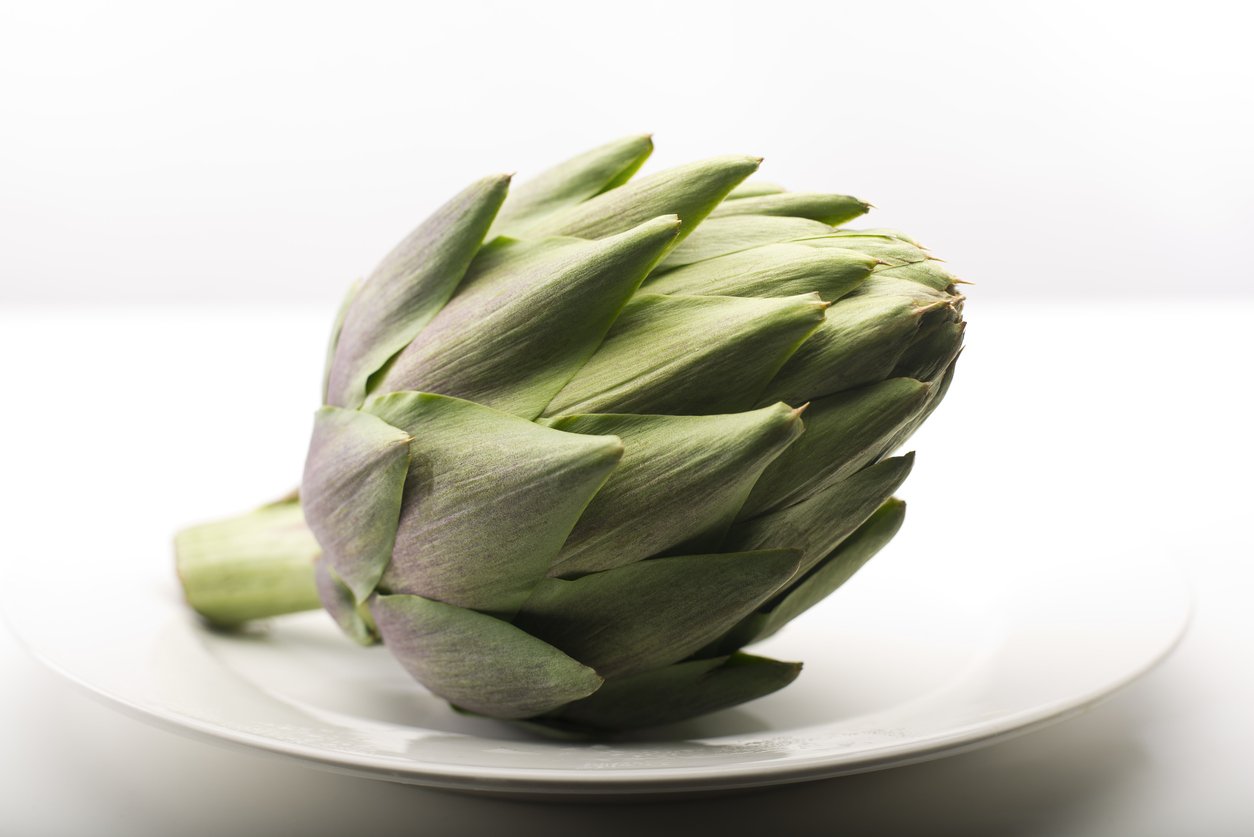
The artichoke, also known as a French or Globe artichoke to distinguish it from the fabulous but totally distinct root vegetable called Jerusalem artichoke, is a vegetable related to the daisy. It’s been the official vegetable of California since 2013 when it beat out avocados in a radio station listeners’ poll.
Originating from inedible thistles, the artichoke is the product of long and intensive cultivation that has created not just a tasty food, but an incredibly nutritious one as well.
Artichoke is a perennial plant native to the Mediterranean region, where 90% of the world’s crop is produced (largely in Spain and Italy). In the US, 99.99% of the domestic crop grows in California. Most artichokes are green, but there are some purple varieties as well. You can also find baby artichokes that are smaller and more tender than their adult cousins.
The truly edible portion of the plant consists of the flesh of the green petals, the center of the stem, and the inner artichoke heart. Attempting to eat the thistly portion in the center of the vegetable can really put the “choke” in artichoke.
It’s one of the realities of our times that food companies aren’t interested in your health, and most doctors don’t know much about food. As if to prove the point, a Miami doctor succeeded in eating an entire artichoke at a restaurant — including the hard leaves. His subsequent pain led him to the hospital, where a laparoscopy discovered undigested leaves lodged in his bowels. In his lawsuit against the restaurant, the physician accused them of not training their wait staff to instruct patrons on the “proper method of consuming an artichoke.” Suggestion: Don’t go to that doctor for advice on how to eat fruits and vegetables.
Artichoke Nutrition Facts
Artichokes pack a powerful nutritional punch. In addition to being a rich source of phytochemicals and antioxidants, artichokes also provide magnesium, potassium, niacin, and folate. Your average artichoke contains almost six grams of fiber, some of which comes in the form of the fabulous prebiotic fiber called inulin.
Inulin is a big deal because it directly feeds and supports the growth and maintenance of colonies of beneficial gut bacteria. It also increases your body’s absorption of certain nutrients, including calcium.
Artichokes have strong antioxidant properties. These are attributed in part to a plant metabolite known as caffeoylquinic acid (which works in part by stimulating your liver to produce bile), as well as flavonoids such as luteolin (which has nothing to do with medieval guitars) and glycosides (compounds in which one or more sugars are combined with nonsugar molecules).
Artichoke nutrition for 1 large fresh artichoke: 76 calories, 17g carbs, 5g protein, 9g fiber, 152mg sodium, 599mg potassium (USDA)
Are Artichokes Good for You?
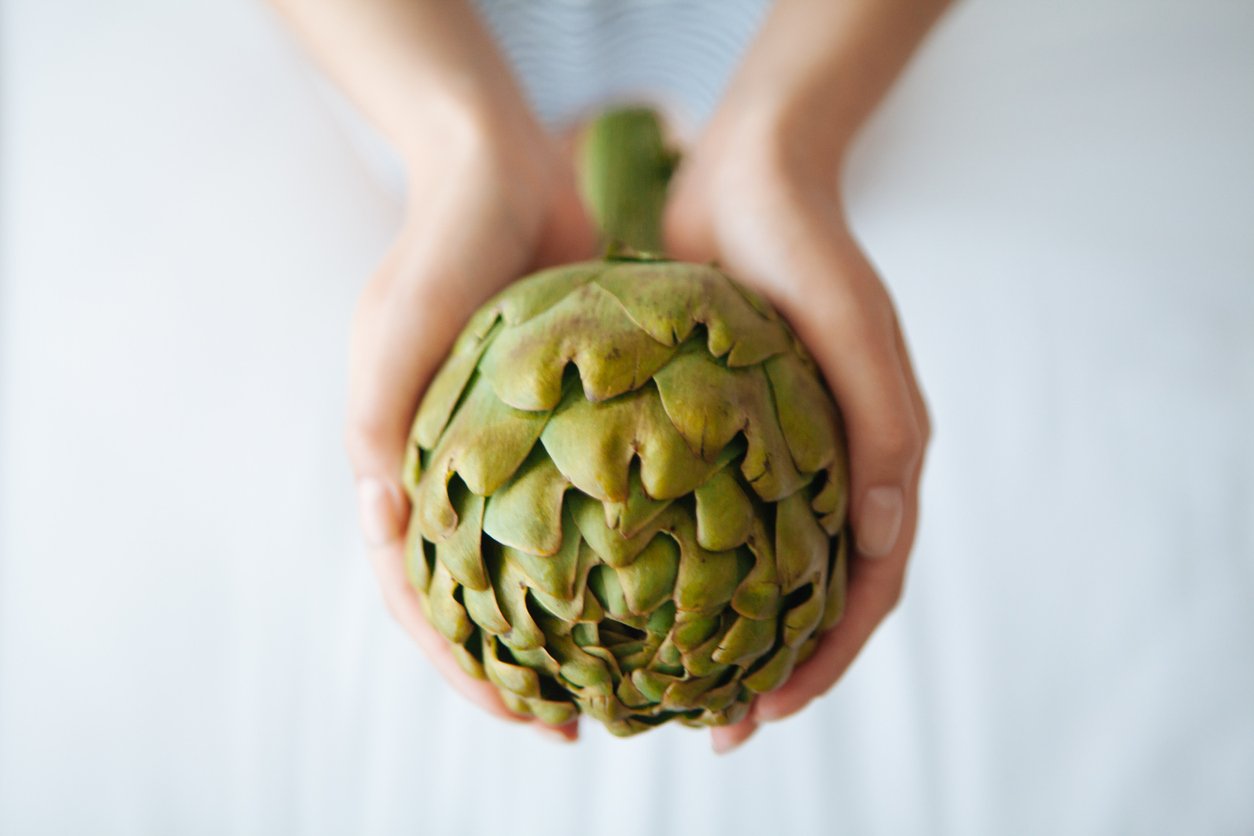
With all that good stuff, it’s no surprise that artichokes demonstrate beneficial effects on a host of diseases and conditions. Let’s explore the health benefits of artichokes and artichoke hearts.
Nonalcoholic Fatty Liver Disease
Artichoke leaf extract (ALE), a supplement derived (can you guess?) from artichoke leaves, has been shown to improve liver function in both humans and mice with nonalcoholic fatty liver disease (NAFLD). (Our view on the use of animals in medical research is here.) The human study followed 100 people with NAFLD for 2 months — half took 600 mg of ALE daily, while the other half got a placebo. The ALE recipients experienced significantly better liver function and a healthier lipid panel than the control group.
Digestion
The prebiotics in artichokes can aid in digestion. A 2015 study out of Argentina found that powdered artichoke fed beneficial strains of Lactobacillus and Bifidobacterium. A 2020 study simulated the human gut microbiome ecosystem in a test tube, and determined that a compound made from artichokes called artichoke aqueous dry extract (AADE) increased the population of beneficial bifidobacteria by 2,500%.
Cancer
There’s been a lot of interest in artichoke’s potential role as a cancer fighter. A 2015 study showed that some polyphenols from the edible parts of the artichoke were able to induce apoptosis (self-destruction) in a line of human breast cancer cells. Egyptian researchers in 2020 found that an extract of artichoke, including the leaves, was able to kill mouth cancer cells.
ALE has been shown to induce apoptosis in certain colon cancer cell strains, and an isolated compound from artichoke leaves, cynaropicrin, has been found to slow the proliferation of thyroid cancer.
Cardiovascular Disease
An unhealthy ratio of LDL (“bad”) to HDL (“good”) cholesterol is a significant precursor and presumed cause of much cardiovascular disease. ALE was one of a number of plant-derived foods found to increase the concentrations of good cholesterol in people with mildly high cholesterol. A 2013 study out of Italy showed that ALE not only increased HDL cholesterol in overweight adults but also lowered LDL and total cholesterol compared to those in the placebo group. And a systematic review and meta-analysis of multiple studies, published in 2021, concluded that artichoke supplementation may significantly reduce blood pressure.
Metabolic Health
Artichokes appear to benefit metabolic health by aiding the body in metabolizing fat for energy, rather than storing it in adipose tissue. A 2018 mouse study found that a couple of different artichoke extracts, including one with luteolin, prevented insulin resistance and inflammation even in animals who were being fed an unnaturally high-fat diet.
Skin Health
It turns out that artichoke, a vegetable named for the scales of a fish, may do wonders for your skin. Italian researchers in 2018 found that artichoke polyphenols blended into a cosmetic cream produced antiaging effects by improving the integrity and function of skin cells.
When are Artichokes Bad for You? (Potential Risks)
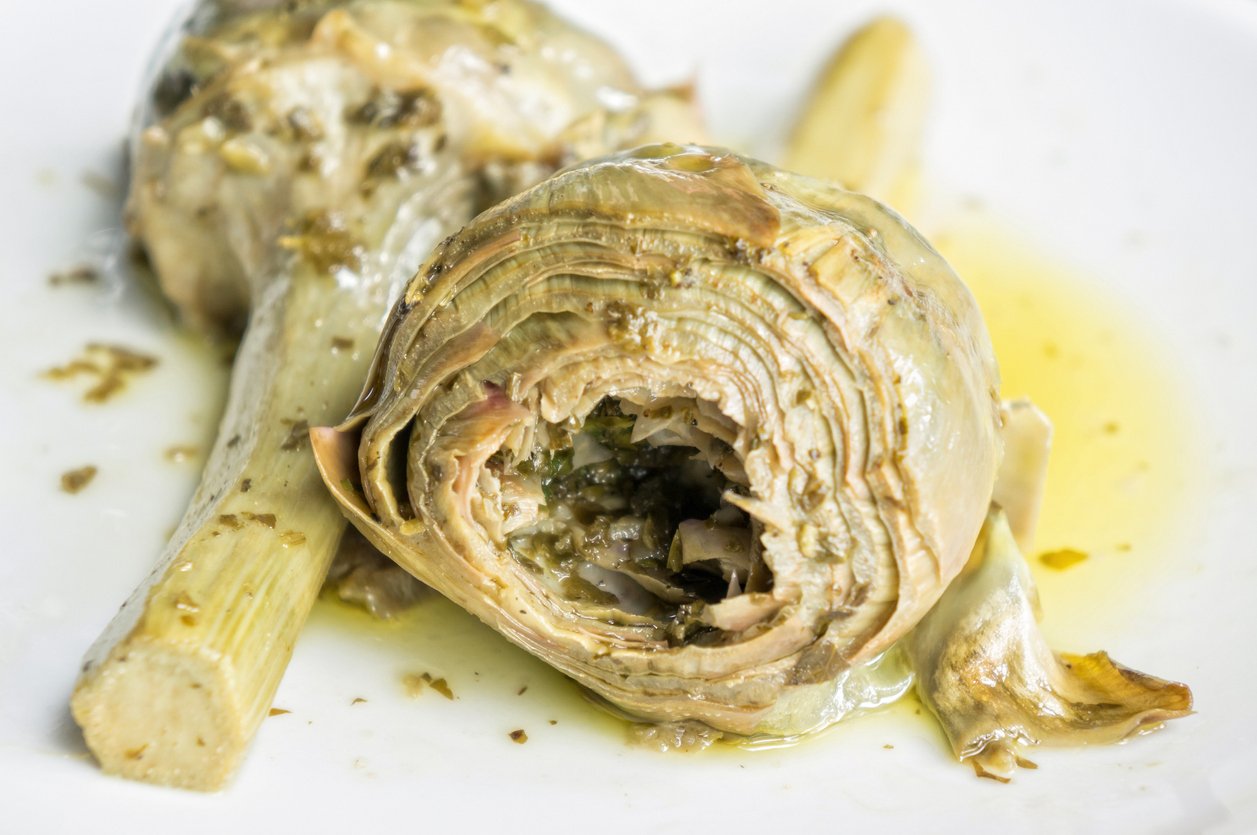
Artichokes are pretty awesome, but there are a couple of concerns that you should know about. It’s rare for anyone to have an allergic reaction caused by consuming artichoke. Very occasionally, an artichoke can trigger oral allergy syndrome in someone highly sensitive to ragweed.
Also, artichokes are so high in fiber, they can cause gas and bloating if you suddenly consume large quantities when your digestive system isn’t used to processing a lot of fiber. The solution typically isn’t to avoid artichokes and other high-fiber foods — rather, it’s to train your gut to handle more and more fiber over time, so you can get the benefits of a high-fiber diet without the discomfort.
The main health danger associated with artichokes is how they’re prepared and what they’re served with. If you cook artichokes at home, you’ll likely steam or bake them. But artichokes served at restaurants are sometimes fried, so before you order an artichoke appetizer at a restaurant, ask how it’s prepared.
Artichokes are often served with a potentially artery-clogging dipping sauce like butter or egg-based aioli. It’s not uncommon for people to regard the artichoke leaves as more of a delivery mechanism for salt and fat than as a food in and of themselves. That’s regrettable for many reasons, including that too much added salt and fat overpower and obscure the more subtle but deeply delicious flavor of artichokes.
You can avoid dairy and egg dipping sauces by making a vegan aioli using tofu instead of dairy, or aquafaba as the egg replacement (you might just find one of those recipes below). Or keep things simple by dipping your artichoke leaves in lemon juice and herbs instead.
How to Choose and Store an Artichoke
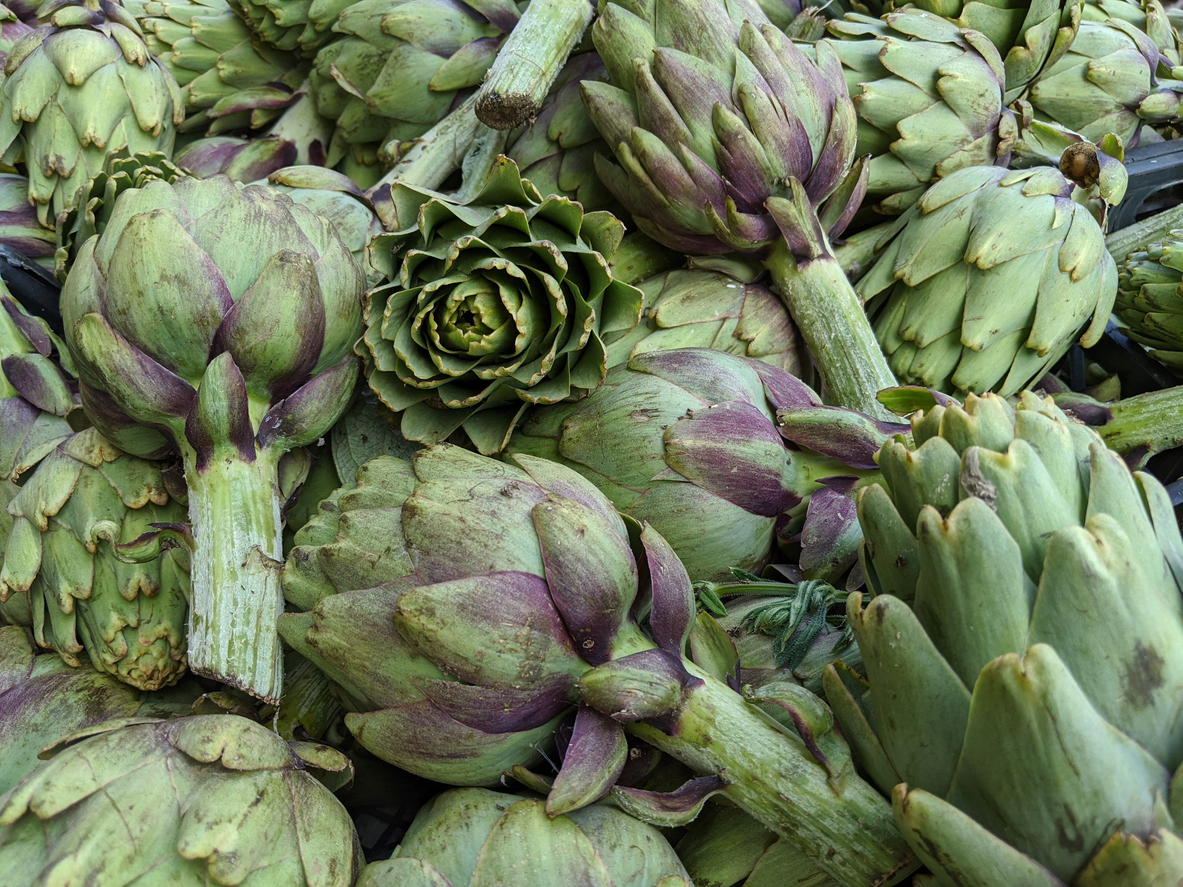
Artichokes have two main seasons, early spring and late summer/early fall. Whole fresh artichokes can be expensive, so it’s important to know how to find ripe ones that are going to be delicious.
One thing you’ll notice is that artichokes vary a lot in size. Typically, the larger ones are more highly prized (unless, of course, we’re talking about the baby variety, in which case good things do come in small packages) as they have more food relative to the thistle, which also makes them more expensive per edible pound. Look for heads with leaves that are tightly closed.
Artichokes are gendered vegetables, and some foodies claim that the female ones taste better. If you want to put this to the test yourself, compare artichokes with rounded petals that point inward (female) to those with straight petals that point up (male).
Whatever your artichoke’s gender, look for globes that are firm and heavy. Avoid heads with a slimy or overly dry stem. And listen carefully, as an artichoke will actually speak to you when it’s ready to eat. That is, hold it up to your ear and squeeze. A perfectly ready artichoke will give a little squeak, courtesy of the firm leaves that indicate ripeness.
In terms of pesticides, artichokes are pretty much average. They don’t make either the Environmental Working Group’s Dirty Dozen or Clean Fifteen lists. And even though residue is reasonably low on the vegetable once it makes it to your supermarket, the chemicals used to treat artichokes still harm farmworkers. Plus they contribute to the decline of important pollinators, such as bees, and they pollute soil and groundwater. So it’s best to choose organic varieties when possible, or buy from local farmers and ask them about their pesticide applications.
You can store fresh artichokes in the refrigerator crisper drawer for up to two weeks. Don’t wash them until you’re ready to cook them. Once cooked, you can freeze the hearts and keep them for about 10 months in an airtight container.
How to Prep and Cook an Artichoke
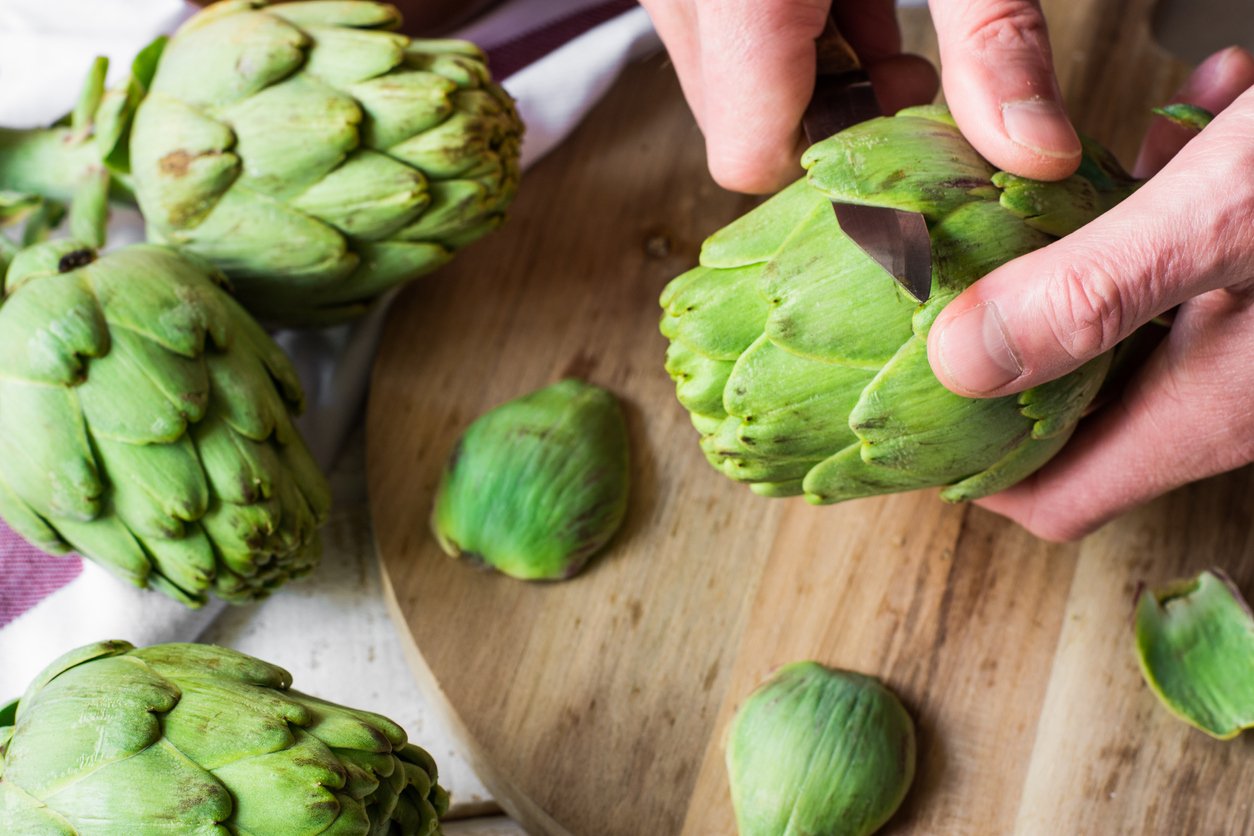
If you’re going to buy a whole artichoke, you’re committing to a certain amount of time for both preparing and eating it. Embrace the slowness of the process, as that’s one of the vegetable’s charms.
To prep an artichoke for cooking, start by cutting off the top with a sharp kitchen knife. Next, snip off the remaining petal tips with scissors or a knife, to remove the thorns. If there’s more than two inches of stem protruding from the bottom of the globe, cut off any excess. Do this both to remove the bitter stem, and to save space in your cooking pot.
Here’s a video, complete with piano music perfect for a silent movie scene of a scheming villain, that demonstrates most of this process.
Now that your artichoke is prepped, you have a few options when it comes to cooking. Steaming artichokes is one of the most popular ways to cook them, but it takes a long time, especially if you’re preparing more than one at a time. You can steam it by placing the prepared artichoke on a rack above an inch or two of boiling water in a stockpot. Cover and steam for 25–45 minutes, depending on size, or until a petal near the center pulls out easily.
You can shorten this process by using a pressure cooker such as an Instant Pot to cook artichokes. Place the artichoke on the rack, and add one cup of water and seasonings as desired. Seal the cooker and let cook at pressure for 13 minutes. Do a quick pressure release (avoid the steam!) and test the artichoke to make sure it doesn’t get overcooked and mushy.
We prefer steaming to boiling artichokes because so many nutrients get lost in the water. However, you can boil an artichoke for 20 to 40 minutes. Tip: Save the water to use in vegetable stock or for cooking grains!
You can also bake or roast whole artichokes in a 400–425° F (200–220° C) oven for 60–80 minutes. To grill artichokes, cut them in half vertically and place them cut-side-down on the grill for 8 to 10 minutes, until they’re done to your preference.
How to Eat an Artichoke
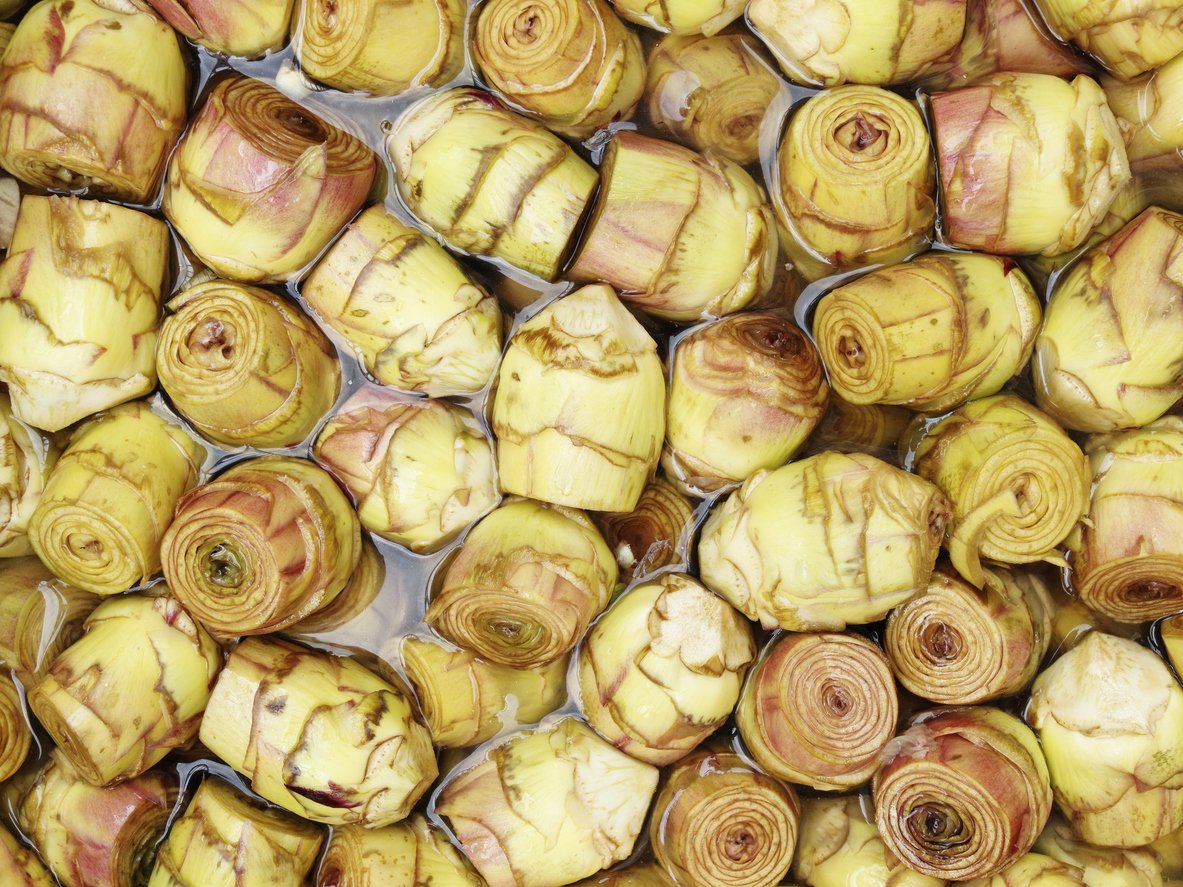
There are two edible parts of a whole artichoke, the fleshy part at the base of each petal, and the heart. Start eating by pulling the leaves off the head and stripping off the petal “meat” with your teeth. If you like, dip the end of the petal into a sauce of your choice.
Once you’ve pulled off all the petals with edible bottoms, you’ll encounter thinner, flimsier petals with little flesh to eat. Remove these (nibbling on as many as you like, if you have the patience). Then use a spoon to scoop the choke (the thistly bit) out from the middle, to get to the artichoke heart, which has a tender, meaty vegetable flavor that’s a delicate combination of slightly sweet and slightly bitter.
If cooking and eating fresh artichoke sounds like more trouble than it’s worth (Narrator: “It isn’t”), frozen hearts are another good option. You can add them to stews and sauces, and roast or bake them with other vegetables.
Canned artichoke hearts are also available but often have added salt and preservatives that can compromise both health and flavor. Plus, metal cans often have interior linings that contain BPA, a hardening agent that’s linked to endocrine disruption and several health problems.
You can also get marinated artichokes in glass jars. While the packaging is fine, these products tend to be high in sodium and contain omega-6-loaded and/or GMO/BE oils, as well as preservatives.
You can enjoy artichokes hot out of the steamer or oven, or you can enjoy them cold. Here’s a short list of ideas for eating whole artichokes:
- By themselves or with a dipping sauce
- Grilled with other vegetables
And here’s where you can add canned or frozen hearts:
- Cold salads
- Pasta
- Dips (like spinach artichoke dip)
- Hot or cold soups
- Sandwiches and wraps
- Pizza
Artichoke Recipes
Now that you’ve learned all about artichokes, are you intrigued by this humble but mighty veggie? It’s time to put that intrigue into practice by using artichokes in a variety of ways from Spinach Artichoke Dip (a favorite here at Food Revolution Network) to Steamed Artichokes with Aioli (a fun way to “get to know” artichokes) to Cheesy Artichoke and Asparagus Penne (one word: YUM!). Whichever artichoke recipe you choose to try first, enjoy the experience of using this unique vegetable in recipes, and be sure to let us know what you think!
1. Spinach Artichoke Dip
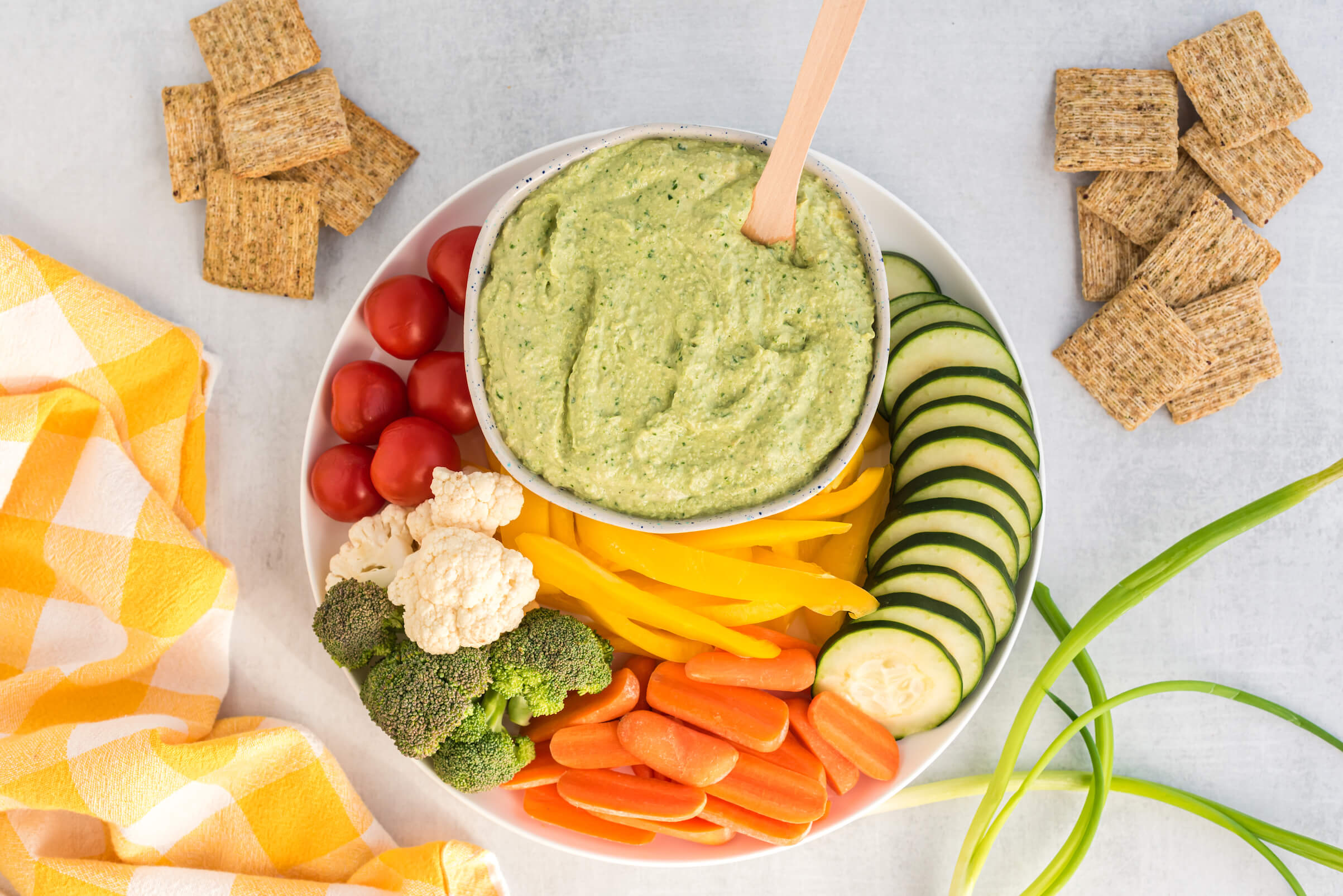
Creating an irresistible, ooey-gooey, plant-based version of Spinach Artichoke Dip requires a few essential ingredients — creamy cashews, cheesy nutritional yeast, and delightful artichokes and spinach. Seemingly indulgent, yet anything but, this dish boasts prebiotic fiber for gut health, magnesium for bone health, and antioxidants for inflammation. Serve it as a veggie dip, spread it on flatbread, or layer it with potatoes and then bake it as a casserole.
2. Steamed Artichokes with Plant-Based Aioli
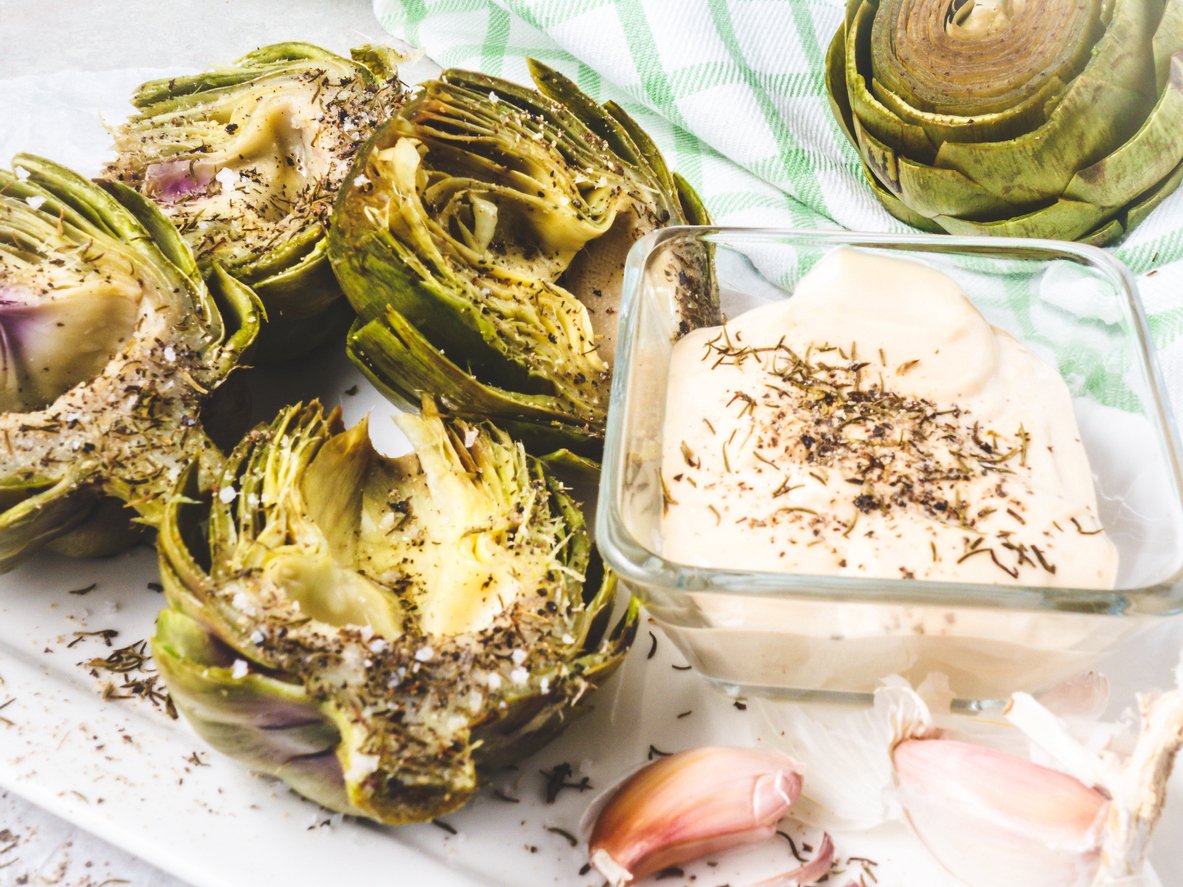
Steamed artichokes with a side of sauce is a classic. It’s been popularized in restaurants and on social media and cooking shows. It’s simple yet elegant, intriguing, and so much fun to enjoy as an appetizer. Serve steamed artichokes with the Plant-Based Aioli in the recipe or with a favorite sauce you have on hand. Visit the Chef’s Notes for suggestions on how to dive in once you’ve placed it in front of your guests!
3. Cheesy Artichoke and Asparagus Penne

If there’s a dish to convince your family that plant-based meals can be nutritious AND delicious it’s Cheesy Artichoke and Asparagus Penne. An array of colors give this vibrant dish vast antioxidant power. What’s more, it’s packed with gut-loving prebiotic fiber from the legume pasta, leeks, asparagus, artichokes, and garlic. Cheesy Artichoke and Asparagus Penne might just create a new mantra, “Eat pasta — heal your gut!”
Conclusion
The artichoke has a long and colorful history that deserves to be much better known. The vegetable is also highly nutritious, with powerful antioxidant properties, abundant inulin fiber, and numerous health benefits. The main downsides to eating it are its oftentimes high price and intimidating thistles. But it’s safe for most people as long as you know how to eat it. And it’s delicious, too!
Tell us in the comments
- Have you ever cooked and eaten a whole artichoke? How did you learn how to do it?
- What’s your favorite healthy dipping sauce that you can use for artichoke petals?
- Which artichoke recipe do you want to try next?
Feature Image: iStock.com/AngelSimon

